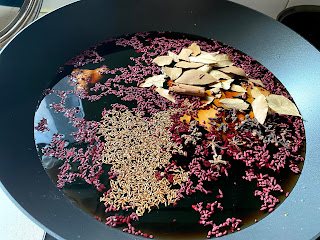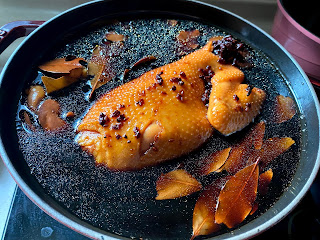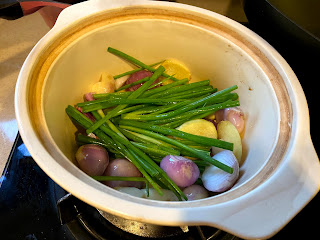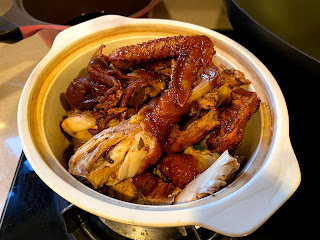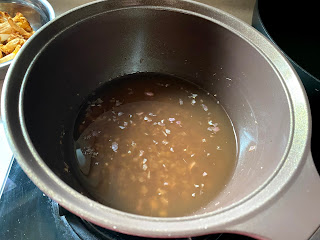This Japanese restaurant has several outlets, and I visited the newly opened flagship located in Causeway Bay Sino Plaza, spanning over 14,000 sq. ft. There are five different sections and instead of trying out their teppanyaki, I booked for the sushi section, because of Chef Okura.
I remembered the first meeting with Chef Okura was a few years ago, at his sushi restaurant in TST. That was a wonderful experience and thanks to him I was introduced to Kohada, one of my favourite’s sushi ingredients till now.
Coming just by myself I was seated at the corner of the long sushi table, served by Chef Okura. I ordered a bottle of Faucon Yukimegami 38 Junmai-Daiginjo ($960). A very balanced sake from Yamagata Prefecture, it paired well with all the dishes and was a good all-round choice.
Ordering the Omakase Menu ($1600), the first course was Mozuku (水雲), a type of seaweed from Okinawa. The seaweed was marinated in vinegar, with a nice appetizing acidity. Chef Okura then put some grated yam, or Yamakake, the slimy texture actually was a nice contrast to mozuku. A great start of the meal.
The second course was Fresh Tomato Salad. From Shizuoka, the tomato was plummy on texture, with a great balance of acidity and sweetness. Together with the green garden salad offering some crunchy bite, and the yuzu jelly giving refreshing note, the starter continued to help warm up the appetite.
The third course was Raw Oyster, or Namagaki. The oyster came from Hokkaido, of a decent size allowing to finish in one bite. Together with the most signature condiment of chives and radish, plus some home-made sanbaizu sauce, the oyster was great in taste, fresh and sweet, without any hint of fishy note.
The fourth course comprised of two types of fish. On the left was Ishidai (石鯛). The rare fish had a clean, sweet taste that was both elegant and having a good bite. On the right was Hirame (平目) wrapping some Sea Urchin. The contrast in the creamy sea urchin was a good complement to the mild note from the flatfish. Both were good.
Then Chef Okura put an abundance of Snow Crab (松葉蟹) meat, which was picked meticulously from the shell, on the serving bowl and then placing some Sea Urchin on top. Again, the way the food was prepared might not seem sophisticated, but true to his reputation, Chef Okura was able to highlight the best original taste of the ingredients and this one was no exception.
Another example of the confidence in his techniques, Chef Okura presented the Botan-Ebi (牡丹蝦) cutting it into sections and then placing on top of a slice of lemon, before squeezing some lemon juice on top. The authentic, original taste of the shrimp was bursting in the mouth, and the bouncy texture was truly fantastic.
Continuing on Chef Okura took out a Tsubugai, and immersed it in icy water before taking it out and then slicing into smaller pieces. Paired with some rock salt, the texture was impeccable, with crunchiness on the side, a more chewy but not rubbery bite on the body. The pairing with the rock salt allowed the umami flavours to be showcased perfectly.
Next was one of my favourites in the evening, with Aji (鯵) cut into small pieces and then added with chopped pickled cucumber, spring onions and a bit of soy sauce. The sweetness from the fish was wonderful, tender on texture and contrasting with the crunchy of the cucumber. Everything was in great harmony.
Following was the best dish in my opinion for the night, the Grilled Taichio (太刀魚). The flesh of the fish was so soft that it simply melted in the mouth. With the silvery skin grilled to a nice sheen, the fish oil was also vitalized to increase the aromas and taste, and adding a bit of lime juice I could eat this one everyday without feeling any regret.
The last sashimi was Katsuo (鰹), with Chef Okura grilling the loin slightly, cooking the outside while leaving the centre part raw. The method is called tataki and one of the signature ways to enjoy this fish. With some chopped onion, finely shredded shiso, and homemade ponzu sauce, this was another fantastic dish, great in taste.
Moving on to the sushi part, the first one was Shima Aji (縞鯵). One reason why I like Chef Okura’s sushi was that the proportion of shari and sashimi was perfect. This piece immediately recalled my fond memories about that. Not only the fish was fresh and tasty, the temperature of shari and acidity was also spot on.
The second sushi was Shinko (新子), smaller Kohada which are less than 5cm long. The attention to process the small fish and remove the bones, marinated with rice vinegar in the traditional manner, was just heavenly in my opinion. Not often seen as it was highly seasonal and took a lot of effort to handle, whenever you can I suggest to try it out, as it was a pure pleasure.
The third sushi was Ishigaki-gai (石垣貝). This shellfish was another of my favourite, with a very sweet taste, bouncy texture which was softer than tsubugai, and thus more suitable to make sushi. With a bit of soy sauce brushed on top to increase the umami, this piece was certainly a winner for most people.
The fourth sushi was Sea Urchin Gunkan-maki. It was good in taste but as the sea urchin had already been featured in two of the earlier dishes, for some it might not be as exciting, unless you are an uni fanatic. I certainly don’t mind the repeat however.
The fifth sushi was Akamutsu (赤鯥), with Chef Okura using the torch-gun to grill the surface a bit to liven up the fish oil, giving a great fragrance that I could smell even from a distance. On the palate it was equally appealing, with intense flavours. No wonder it was many Japanese’ most sought-after sushi.
The sixth sushi was Hiramasa (平政), the name of young yellowtail caught in summer. Most people would know better the mature fish caught in winter, called buri. While this might not have the same fat contents as the mature fish, the belly used still got a rich fish oil and was great in taste.
Continuing on it was the anticipated Chu-toro. With the fat level up another level from the last piece, the softer texture and more concentrated flavours would make even a sushi novice understand why the tuna cut was liked by so many diners. Personally it was also my preferred cut than the more expensive O-toro as the fat level of the latter was a bit too overwhelming.
Coming to the end the Anago (穴子) was served. The sea eel was grilled and brushed with a home-made sauce, with the sweet and umami note permeating in the soft, and flavourful eel. Another great sushi to conclude this wonderful meal.
While drinking the hot and tasty milky-white Fish Soup, the chef asked whether I wanted more sushi. Without shame I asked for an encore of Shinko, and happily Chef Okura made another one for me, to savour this wonderful taste for another occasion.
Then I asked for a favour, and requested the signature sushi made with Menegi (芽葱). Chef Okura gave me a knowing smile, and I was not sure whether he recognized I must have visited him before, or this would be provided anyway even without actually asking. No matter what, it was a good palate cleanser, with a mild and delicate note from the tiny leek.
Coming to dessert, the first was a slice of Melon, with the fruit juicy and very sweet. Next was the Yuzu Sorbet, with the nice citrus yuzu note of good acidity balancing with sweetness, creating the perfect ending for the meal.
The bill on the night was a reasonable $2,816. On the same table there was another Japanese couple, apparently patrons who visited Chef Okura often. While the staff was attentive, I honestly felt a bit ignored throughout the meal by the chef. Not sure whether it was because I came by myself and looked intimidated, but I believe if there could be more interactions the whole dining experience would be even more wonderful.

